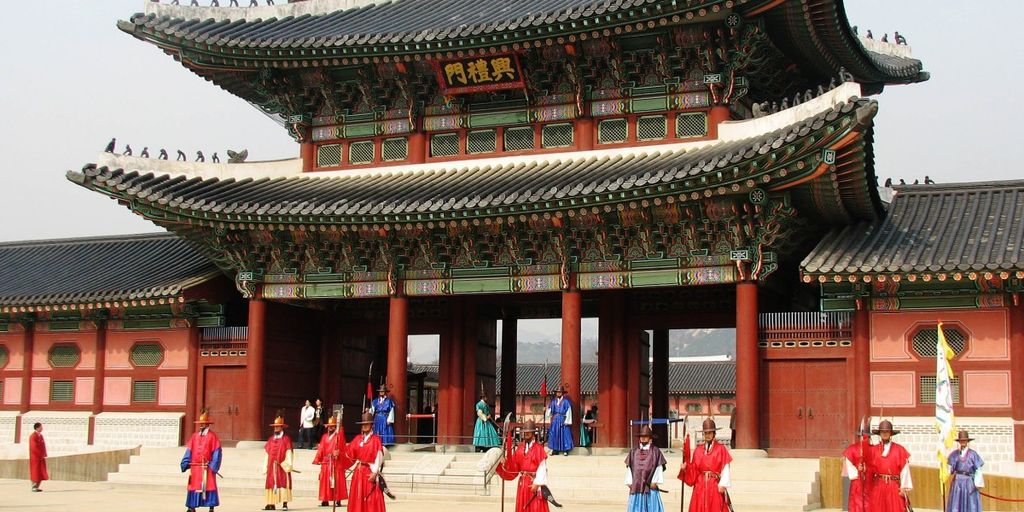South Korea harbors a millennia-old cultural heritage that will transport you through the centuries. From the majestic palaces of the Joseon Dynasty to the impressive Buddhist temples like Bulguksa Temple and Haeinsa, every step you take in this country will connect you with its fascinating past. In addition to its architectural marvels, Korea’s intangible cultural heritage, including traditional rituals, music, and crafts, offers a deep dive into the living expressions passed down through generations. This article explores Korea’s rich heritage, focusing on its temples, palaces, and enduring traditions.
Key Takeaways
- South Korea’s cultural heritage spans centuries, offering a rich tapestry of historical and cultural sites.
- The palaces of the Joseon Dynasty, such as Gyeongbokgung and Changdeokgung, are prime examples of Korea’s royal architecture.
- Buddhist temples like Bulguksa and Haeinsa are not only spiritual sanctuaries but also masterpieces of art and architecture.
- Korea’s intangible cultural heritage includes unique traditions like Jongmyo Jerye, Talchum, and Kimjang, showcasing the country’s living cultural expressions.
- Exploring Korea’s heritage provides a comprehensive understanding of the nation’s history, art, and cultural practices.
Majestic Palaces of the Joseon Dynasty
The Joseon Dynasty, which ruled Korea from 1392 to 1910, left behind a legacy of stunning palaces that reflect the grandeur and sophistication of the era. These palaces are not just architectural marvels but also hold deep historical and cultural significance.
Gyeongbokgung Palace: The Main Royal Palace
Gyeongbokgung Palace, built in 1395, is the oldest and largest of the Five Grand Palaces constructed during the Joseon Dynasty. Its name means "the greatly blessed palace." Located in the heart of Seoul, it served as the main royal palace and housed major government offices. The palace’s location, with running water before it and Bugaksan Mountain behind, was considered ideal according to geomantic principles.
Changdeokgung Palace: A UNESCO World Heritage Site
Changdeokgung Palace, located in Jongno-gu, Seoul, is one of the five Royal Palaces of the Joseon Dynasty. Built in 1405 as a royal villa, it became the official royal residence after Gyeongbokgung was destroyed by fire in 1592. The palace is renowned for its beautiful ‘Secret Garden,’ which offers a peaceful retreat behind the main buildings.
Deoksugung Palace: A Blend of Western and Korean Architecture
Deoksugung Palace is unique for its combination of traditional Korean and Western-style architecture. Originally a residence for a royal family member, it became a palace during the later years of the Joseon Dynasty. The palace grounds feature a mix of historical buildings and modern structures, reflecting Korea’s transition into the modern era.
Buddhist Temples: Spiritual Sanctuaries
Bulguksa Temple: A Masterpiece of Buddhist Art
Bulguksa Temple, located in Gyeongju, is one of Korea’s most famous temples. It is known for its stunning architecture and beautiful gardens. The temple was built in 774 and is a fine example of Silla architecture. Visitors can explore the Cheongungyo (Blue Cloud Bridge) and Baegungyo (White Cloud Bridge), which are famous structures within the temple complex.
Haeinsa Temple: Home to the Tripitaka Koreana
Haeinsa Temple, situated on Mount Gaya, is renowned for housing the Tripitaka Koreana, a complete collection of Buddhist scriptures carved onto wooden blocks. This temple, established in 802, is a significant site for Korean Buddhism. The Tripitaka Koreana is considered a national treasure and is admired for its precision and craftsmanship.
Jogyesa Temple: The Center of Korean Buddhism
Jogyesa Temple, located in downtown Seoul, is the chief temple of the Jogye Order of Korean Buddhism. It serves as a spiritual center and a place for various Buddhist ceremonies and events. The temple is easily accessible and offers a peaceful retreat from the bustling city life.
Visiting these temples provides a unique insight into Korea’s rich spiritual heritage and architectural brilliance.
Intangible Cultural Heritage: Living Traditions
Korea’s intangible cultural heritage includes traditions and living expressions inherited from ancestors and passed on to descendants. These traditions encompass oral traditions, performing arts, rituals, festive events, and the skills to produce traditional crafts. UNESCO has recognized twenty examples of Intangible Cultural Heritage in Korea, highlighting the country’s unique cultural history and preservation efforts.
Royal Ceremonies and Court Life
The Admission Ceremony of the Crown Prince
The Admission Ceremony of the Crown Prince marks the start of formal education for the future king. This grand celebration will take place amidst the historic splendor of Seoul’s five royal palaces. The ceremony includes various rituals and traditions that have been passed down through generations.
Royal Banquets: A Feast for the Senses
Royal banquets were elaborate events that showcased the wealth and culture of the Joseon Dynasty. These banquets featured a variety of traditional Korean dishes, music, and dance performances. The royal family and their guests enjoyed a feast for the senses, with beautifully arranged food and captivating entertainment.
Jongmyojereak: Music and Dance of Ancestral Worship
Jongmyojereak is a traditional performance that combines music and dance to honor the ancestors of the royal family. This ceremony is held at Jongmyo Shrine, a UNESCO World Heritage Site, and is an important part of Korea’s cultural heritage.
The intricate details of these ceremonies are recorded in beautifully illustrated books, ensuring that the traditions are preserved for future generations.
The Ancient Kingdom of Silla
The Kingdom of Silla was one of the Three Kingdoms of Korea, alongside Goguryeo and Baekje. It lasted from 57 BC to 935 AD and was known for its rich culture and artistic achievements. Gyeongju, the capital of Silla, is often called “a museum without walls or roof” because of its many archaeological sites.
Exploring Korean Folk Traditions

Korean culture is rich and diverse, with a unique blend of ancient traditions and modernity. The hanbok, the traditional Korean dress, is one of the most recognizable garments and can be seen at festivals and special occasions. Traditional Korean music, known as gugak, captivates with its melodies and the elegance of its instruments, such as the gayageum (zither) and the janggu (drum).
Hanbok: The Traditional Korean Dress
The hanbok is a beautiful and colorful traditional Korean dress. It is often worn during festivals, celebrations, and special events. The design of the hanbok is unique, with vibrant colors and simple lines that create an elegant look. The hanbok represents Korea’s rich cultural heritage and is a symbol of national pride.
Pansori: Korean Musical Storytelling
Pansori is a traditional Korean form of musical storytelling. It involves a singer and a drummer who perform epic tales through song and rhythm. Pansori is known for its expressive vocal style and dramatic narratives. This art form is an important part of Korea’s intangible cultural heritage and continues to be performed today.
Folk Paintings: Minhwa Art
Minhwa refers to Korean folk paintings that depict everyday life and customs. These paintings are often colorful and whimsical, featuring animals, plants, and scenes from daily life. Minhwa art is cherished for its simplicity and charm, and it provides a glimpse into the lives and beliefs of the Korean people.
Korean folk traditions are a testament to the country’s rich cultural heritage and continue to be celebrated and preserved in modern times.
Historic Fortresses and Tombs
Hwaseong Fortress: A UNESCO World Heritage Site
Hwaseong Fortress is a remarkable example of late 18th-century military architecture. The fortress is a “living record” that shows the changes in fortification techniques from the 7th to the 19th centuries. It was built under the orders of King Jeongjo of the Joseon Dynasty to honor and house the remains of his father, Prince Sado. The fortress includes four main gates, secret gates, and observation towers.
Gochang Dolmen Sites: Prehistoric Monuments
The Gochang Dolmen Sites are home to hundreds of dolmens, which are ancient stone burial markers. These dolmens date back to the 1st millennium BCE and are some of the best-preserved examples in Korea. They provide valuable insights into the funeral customs and social structures of prehistoric communities.
Royal Tombs of the Joseon Dynasty: Eternal Resting Places
The Royal Tombs of the Joseon Dynasty are highly regarded as tangible heritage reflecting the value of Joseon funeral customs, which were derived from Confucianism and geomancy. The tombs feature one or more semispherical mounds protected with curbstones set around the base and elaborately carved stone railings and stone animals such as a lamb and a tiger. In the front area is a rectangular stone table that was used to offer sacrifices to the spirits of the royalty.
The Royal Tombs of the Joseon Dynasty are not just burial sites; they are a testament to the rich cultural and historical heritage of Korea.
Conclusion
Exploring Korea’s heritage is a journey through time, offering a profound connection to the country’s rich cultural tapestry. From the majestic palaces of the Joseon Dynasty to the serene Buddhist temples like Bulguksa and Haeinsa, each site tells a story of Korea’s historical and spiritual legacy. The preservation of intangible cultural heritage, including traditional crafts, performing arts, and rituals, further enriches this experience. Whether you’re walking through ancient fortresses or participating in traditional ceremonies, Korea’s heritage deserves to be uncovered and celebrated. This exploration not only deepens our understanding of Korea’s past but also highlights the enduring beauty and significance of its traditions in the modern world.
Frequently Asked Questions
What are some must-visit palaces from the Joseon Dynasty?
Some must-visit palaces from the Joseon Dynasty include Gyeongbokgung Palace, Changdeokgung Palace, and Deoksugung Palace.
Which Buddhist temples in Korea are renowned for their historical significance?
Renowned Buddhist temples in Korea include Bulguksa Temple, Haeinsa Temple, and Jogyesa Temple.
What is the significance of Jongmyo Jerye?
Jongmyo Jerye is an ancestral ritual that includes music and dance, recognized as an Intangible Cultural Heritage by UNESCO.
What traditional Korean dress is commonly worn during cultural celebrations?
The traditional Korean dress commonly worn during cultural celebrations is called Hanbok.
What is Kimjang and why is it important in Korean culture?
Kimjang is the tradition of making and sharing kimchi, an important aspect of Korean culture that fosters community and family bonds.
What are some notable historic fortresses and tombs in Korea?
Notable historic fortresses and tombs in Korea include Hwaseong Fortress, Gochang Dolmen Sites, and the Royal Tombs of the Joseon Dynasty.

